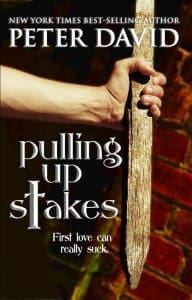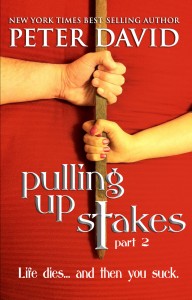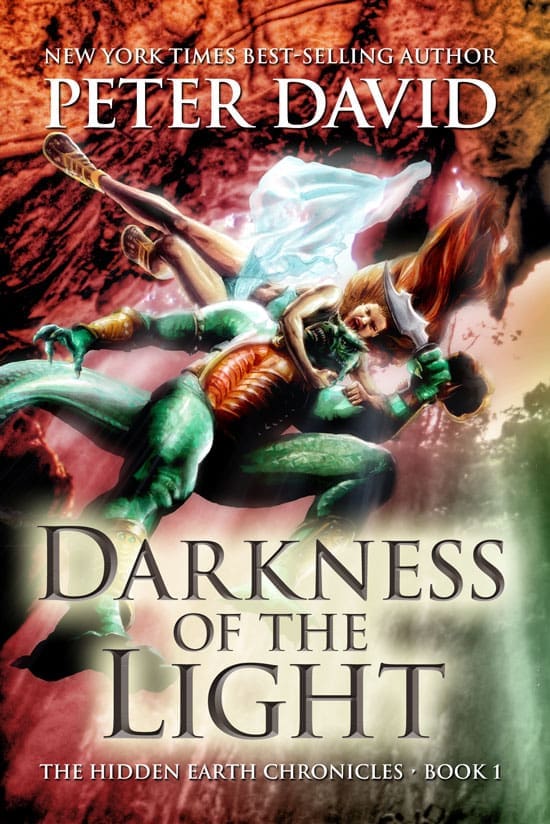 Originally published October 16, 1998, in Comics Buyer’s Guide #1300
Originally published October 16, 1998, in Comics Buyer’s Guide #1300
“Bring back Kara.”
It’s probably the most oft-repeated (if I were cynical or in a bad mood, I’d say “tired”) refrain that I hear as the current writer of the Character Currently Known as Supergirl (and Formerly Known as Kara Zor-El.)
Even those people who like the character’s current incarnation have their first loyalty to Superman’s cousin, who was wiped out of existence during Crisis on Infinite Earths. I’d say “unceremoniously wiped out,” but there was more ceremony, pomp and circumstance around her demise than one usually sees at the average college graduation. There are some fans who would happily see Matrix/Supergirl vanish from the DC universe in a burst of flame if it meant Kara’s return. There are others who sufficiently like her current incarnation, plus supporting cast, to want to keep her around even if Kara came back, but simply call her something else other than “Supergirl” so that the name could be returned to the previous owner.
Yes, yes, I know, Kara wasn’t the “original” Supergirl. There was another one in an earlier story who was a one-shot appearance. And yes, I also know there’s a “Kara” who showed up in a DC/Dark Horse crossover whose presence remains a constant source of interest to fans. But for the purpose of this little dissertation, I’ll be confining all my references to that Silver Age pixie who popped out of a fallen space ship and announced her (fairly obvious) presence to a somewhat startled Superman.
No longer unique. The advent of Supergirl was one of the first steps in the de-uniquing (there’s a new word) of Superman. When something is successful (as Superman unquestionably was) there is a compulsion to try and imitate that success by imitating the originator of it. That’s where spin-offs and sequels come from. It’s not so much a creative impulse as it is a corporate one. Thou Shalt Create New Books and Characters Who Will Sell—and the way to improve the chances of their selling is by creating parallels or tie-ins to established, proven properties.
By the time the 1960s rolled around, Superman had gone from being the last survivor of the doomed planet Krypton (“That’s what we get for naming the place after an element!” said an annoyed Jor-El in a Mad spoof) to being one of a crowd of refugees on par with the Boat People. There was Superman, Supergirl, the Superdog, the entire bottled city of Kandor, even the Phantom Zone villains.
But, as Superman’s popularity diminished over the years, sales dropping precipitously so that the Superman family was among the lower selling of the Big Two’s titles, the feeling seemed to be that the imitation—rather than being the sincerest form of flattery—had cost the Big Blue guy. He was no longer unique, and that was suddenly a bad thing. Something had to be done. The Super-hangers-on had piled onto the Superman legend so thickly that you couldn’t see the original guy anymore, and they had to be scraped away like barnacles.
Just as Supergirl’s advent was emblematic of Superman becoming one of the gang, Supergirl’s demise was one of the first steps in transforming the Man of Steel back into the Last Survivor of Krypton. And she was done away with about as comprehensively as any character could be obliterated. She was wiped right out of existence. Not only was she dead, but thanks to rebooted continuity, she had never lived in the first place. Fans howled, fans raged.
What they did not do, of course, was support her from a sales point of view in the first place.
In terms of sales success, Supergirl was right up there with Hawkman and Aquaman as someone who had a following, but never sufficiently large enough to wield any sort of sales clout. No one ever seemed to know quite what to do with her. So why is it that a character who was, at best, a back-up character, and at worst a cheap female knock-off created primarily to cash in on Superman’s popularity—why and how has she retained such a hold on the hearts and minds of fans?
There is, of course, the simple answer: All you have to do to get fans to want something is to take it away from them. Fans expressed boredom with Chris Claremont on X-Men—until he forcibly had to part company with the series. And now rumors of Claremont back on the mutant titles is enough to kick the salivary glands of fans everywhere into overdrive. When Jean DeWolff was knocked off in one of my earliest Spider-Man stories, we were deluged by letters from people claiming that she was their favorite character—even though her over-a-year absence from the titles had garnered virtually no inquiries whatsoever as to her whereabouts. Both characters and creators who are taken for granted are suddenly coveted once the fans don’t have them to take for granted anymore.
But it may be a bit more complicated than that.
Part of it is that Kara made a terrific first impression. She was young, naive, eager-to-learn—and, most enticingly, she was a secret. Rather than simply announcing her presence to the world, Superman opted to keep her under wraps. Since Superman was apprehensive about Supergirl’s existence being exposed, and was concerned about how she would interact with the unfamiliar planet, he naturally did the one thing that made no sense at all: he plopped her in an orphanage, providing maximum danger of her blowing her identity since it hinged on her ability to interact smoothly with a species she had never met, plus she had to keep that dámņëd wig on.
Why she needed a wig at all was also somewhat questionable. Why not just let her walk around with her normal blonde hair hanging out? No one was going to look at her and say, “Hey, you’re Supergirl!” considering that Supergirl didn’t officially exist. If for some reason she needed a disguise, what was wrong with tying her hair back and wearing glasses. You never saw Clark wearing a wig. And if later on, Superman chose (as he eventually did) to “out” her, she could have worn a mask to conceal her identity at that point in the event that glasses weren’t deemed sufficient. Go figure.
Secret appeal. The thing is, since Kara was a secret, that made her mightily appealing to the readers. We were all in on the secret as well. Not only that, but her adventures were necessarily smaller scale than Superman’s. As opposed to grand cosmic epics, Supergirl’s adventures were more intimate, and oftentimes tests of her ingenuity since she couldn’t make any sort of public appearance. Right at the start, she deemed herself as Midvale’s “guardian angel” (a term that became somewhat literal since I started on the character’s new incarnation).
Plus, Kara seemed so gosh-darned eager to please. To please not only Superman, but us. Her every appearance seemed to cry out, “Like me, like me!” It was hard not to. It would have been like clubbing a baby seal. This perky blonde in her little ice-skating, blue-skirted outfit, was a combination of every kid sister you ever had to look out for, and every girl in class you ever had a crush on.
And talk about crushes—good God, was there ever any character, anywhere, who had more miserable taste in men than Supergirl? She didn’t just encounter the standard, run-of-the-mill schmucks in the dating pool, no, not our girl. Like mosquitos to a fat farm, the most inappropriate mates in the galaxy swarmed to her. If there was a fugitive from a space prison in the area, or an escaped Phantom Zone villain, or someone on the run from the future, or some guy hiding from the past, or a disguised horse—they zeroed in on Supergirl, and she loved them all. And they used her, or loved her, depending upon their disposition.
Perhaps that’s what drew us to her, on an emotional level. As she drifted from one loser beau to the next, we couldn’t help but wish that somehow we could enter the comic and treat her right. We wouldn’t betray her or trap her or use her for vicious, evil ends.
Hëll, even Superman was attracted to her, and not just in a big brother fashion. In one memorable story, Supergirl set out to find the ideal mate for her cousin, without much success. When she sorrowfully informed Superman of her failure in the matchmaking department, she is astounded when he chucks her under the chin and told her that if he were on the lookout for Mrs. Superman (his lack of interest, I’m sure, likely coming as the ideal piece of news to Lois Lane) that as far as he was concerned, he’d look no further than Kara herself (and boy, did she look jazzed when he said that).
Readers got the impression that, all things being equal, he’d gladly have wedded her on the spot. And indeed, if one believes Larry Niven’s “Man of Steel, Woman of Kleenex” analysis of Superman’s sex life, Supergirl might indeed be one of the few females on earth who could have handled a night of ardor with the caped one. (For that matter, a non-super male might not have much more luck withstanding a fling with Supergirl. Her super-legs wrapped around you could easily crush you in the throes of passion, to say nothing about spasms in other parts of the body that could prove equally lethal.)
However, since cousins couldn’t marry under Kryptonian law, such a union was out of the question. Considering that Krypton no longer existed except in the shape of assorted hues of rocks, one would have thought that such strictures might have been tossed by the wayside—particularly if it meant the potential propagation of the Kryptonian race. But this was back in the days when Superman never met a rule he didn’t obey. Supergirl subsequently found an older, dead ringer for herself to match up with Kal-El, but she couldn’t survive on our world. Que sera sera.
Also, as opposed to Superman’s graven-in-stone existence, Supergirl’s young life changed. She got adopted parents and a new name, and wound up revealing her identity to them. Superman went public with her existence as well, introducing her to the world once he’d decided she was ready. One got a sense of growth and development—
—and then she foundered. With lack of solid growth and consistent vision, Supergirl started simply to be… there. And that was all.
Perhaps that was part of the reason that Supergirl never really “flew” as a solo star. Aside from being eager to please, she wound up having no real identity outside of Superman. Once she was ready to fly on her own—she plummeted. Her forays into her own title were marked by reader disinterest and uneven stories as writers sought ways to make her distinct from her more famous cousin.
Particularly memorable was the complete loss of her powers and the substitution of an exo-skeleton, plus an array of costumes that would have made Janet van Dyne envious in terms of their variety.
Somehow, out from under Superman’s wing, she just wasn’t that interesting. We were rooting for her, certainly—but we weren’t sure what we were rooting for her to do. We knew that we didn’t want her to die, of course. We just wanted her to appeal to us in that same cousin/kid sister/first crush way that she had intrigued us during her earliest appearances. But as Supergirl grew up, she grew away from us as well, leaving behind whatever claims to uniqueness (personality wise) she may have had and became little more than, well, a female Superman. She was at best a redundancy, at worst an annoyance.
Who better to target for a dramatic hero’s death than Supergirl? Well, maybe the Flash, who had become the world’s fastest man trapped in the world’s slowest story, namely his endless “trial” which effectively killed the book. But the Flash was quickly and easily replaced with Wally West and was instantly revitalized. Supergirl was a bit more problematic; no one could just step in and take her place.
But when Supergirl did return, it seemed to fans like a massive tease and cheat. In name and general appearance she was Supergirl; in reality, she was a protoplasmic blob from a “pocket universe” (whatever the hëll that is) that, in subsequent continuity, had never existed in the first place. She’d gone from living in Superman’s shadow to living in his shape (when she impersonated Clark Kent).
When I took on the book, I was all too aware that any number of fans would just as soon have seen Kara return and take up her mantle once more. But that wasn’t going to happen; DC wasn’t going to dilute Superman’s status again. Still, I wanted to make the fans feel more at home. So I gave her as many of the exterior accoutrements of Kara’s former life as I possibly could. I gave her parents, and a secret identity of Linda Danvers, in a small town (called “Leesburg”, in deference to Linda Lee), and a boyfriend named Ðìçk Malverne, and put Stanhope College nearby. Some fans thought I was being “in-jokey.” Nah. I just wanted to make the old readers feel at home as best I could.
And her abysmal taste in men continued unabated. This grand tradition was carried over near the beginning of her re-creation as she hooked up with, of all people, Luthor. I mean, good lord, the only way Supergirl goes more romantically wrong than that is if she has Darkseid’s love child. I decided to maintain that spirit of questionable judgment by having her get involved with a demon from hëll, followed by involving both her identities in a four-way love triangle with (honest to God) a super-powered horse-being whose double identity is a randy lesbian.
It took me ten issues to spell out the truth of what was going on with Linda and Andy and Supergirl and Comet (a name taken from her old superhorse pet/paramour). Can you blame me? You don’t drop one like that on the readers over the course of a two-parter.
Rumors in the hopper indicate that DC may bring back the entire multiverse concept, effectively undoing the last vestiges of Crisis. I wouldn’t have thought it likely, but I suppose anything is possible. If that’s the case, then who knows? Kara may return.
And have I got a guy for her…
(Peter David, writer of stuff, can be written to at Second Age, Inc., PO Box 239, Bayport, NY 11705.)





I LOVE seeing old posts like this. 🙂
Thank you, for this! 😀
Supergirl #25 featured one of the best last-page-reveals I’ve ever encountered. One of my all-time favourite comics. Thank you.
I wasn’t 100% sure if that was the issue i thought it was (turns out it was).
SO i looked it up, and i’m reading it right now.
The last-page reveal is, indeed, great – but i love page 10: “…your prayer technique needs a lot of work.”
Heh heh heh, home run!
Supergirl (your run) is one of my favorite runs in comics ever. As complicated as the backstory was, the heart of your run was just excellent. It’s too bad DC had to end it as unceremoniously as they did.
My first wife finished the issue of “Crisis” where Kara checked out … and said “How dare they make me feel so bad about the death of a character I don’t even like?”
My favourite comic Book run of yours. Too bad it isn’t collected in its entirety!
Peter David’s “Supergirl” is in my humble opinion still the greatest series ever published in the entire history of DC Comics.
The mid-90s Supergirl series came at a time when I had pretty much walked away from new comics because of the publishers’ catering to the speculator market earlier in the decade, and the corresponding general drop in story quality. I truly regret that concerning Peter’s take on Supergirl; I would have loved to have been picking that book up month to month, with the corresponding anticipation that it would have brought, rather than reading much of the series in a large chunk of back issues. Supergirl/Matrix/ “Mae” was one of my particular favorites of the post-Crisis Superman supporting cast, and I love what Peter did with the character.
Still a big fan of PAD’s SG run, which is far more than I can say about what DC’s done with Supergirl ever since. Talk about the idea of ‘be careful what you wish for’…
Many happy returns, Peter!
Even though it was not the Supergirl I grew up on, I really liked your take on the character, and it did work as a post-Crisis version.
After you stopped writing she just became a tramp. Can’t abide her.
I’ve already gone into detail all over the Internet about how it was Supergirl, not Cousin Kal, who got me started seriously collecting comic books. I would’ve been six or seven at the time, and it helped for me that, when I first saw her, she turned into a baby. If she’d been just a little bit older, she would’ve been right for me.
A couple of things:
I think the “That’s what we get for naming the place after an element!” came from Marvel’s “Not Brand Ecch!” parody of Superman “Stupor-Man,” I think it was? Not an original name. But, boy, did it go after what Mort Weisinger was doing to the character.
Then, there’s the issue of “Adventure” that as “inspired” by the then-new computer-dating fad. Supergirl used the computer in Superman’s fortress to find the perfect beau for herself from all the super-guys in the universe. The one it selected lived on a planet that a space-ship’s ray what caused all the men to become hyper-chauvinists and their women to be subservient. I think the story has been repeated in a Showcase “Supergirl” volume. But the story’s big reveal may explain a lot about Supergirl’s love life.
I certain liked this Kara much more than the current version who doesn’t seem to care much about anything and is still in shock from Krypton’s destruction.
Then again, we may have some fun with what they’ve started between the rebooted Supergirl and rebooted Power Girl.
Mr. David’s run on Supergirl is one of the few comics I’ve gone out of my way to collect the complete run.
A big part of it was characters one could care about. Even Buzz. I’d initially looked forward to seeing him get his head handed him and yet couldn’t help feel a touch sorry for him when, well, that would be telling. But the end of his storyline was quite satisfying, just not the way I’d expected.
And then there were the wonderful twists. The dangerous, powerful Gorilla grodd taken out by … ??? I had to reread that one to make sure I hadn’t read it wrong.
Not to mention *The Issue* where SG goes up against the alien battlefield scavenger. I lost track of the accepted concepts that one turned hilariously, and quite rightly on their head. From the perfect “Uh, breath mint?” cover to her leaving the cops by honouring their wishes … perfect, just perfect.
To think this was replaced by … well, they lost me when they introduced the new version’s ‘look’. I didn’t mind at all the skimpy two-piece outfit, but to claim it was Ma Kent who’d came up with it for her? A minor point, but it killed it for me. Loss of suspension of disbelief and all that.